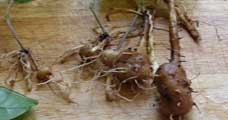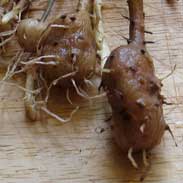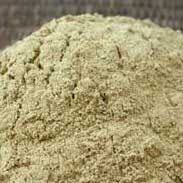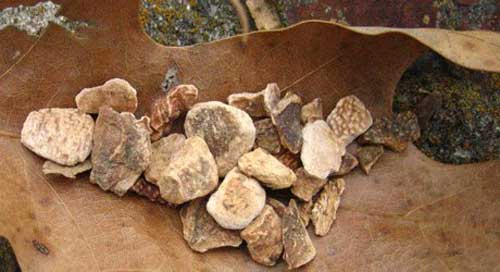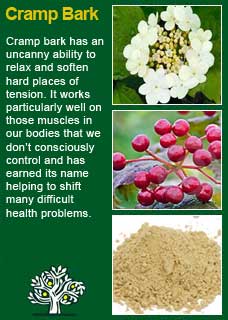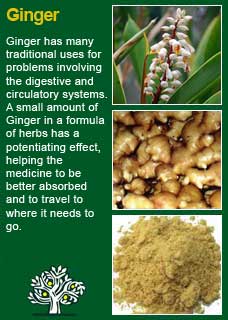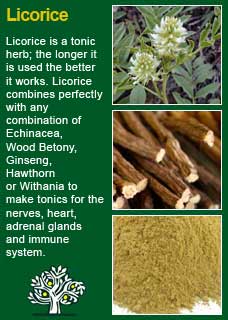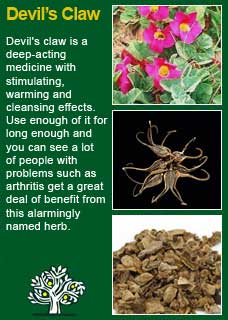
|
|
||||
| Our Pages ABOUT CONSTITUTIONAL MEDICINE
|
The root of a long lived, curling and twisting vine that grows widely in the Eastern USA. Wild Yam root becomes very hard when dried and has a distinctive, bitter flavour with a long, lingering aftertaste.
As some of the other common names for Wild Yam demonstrate (Colic root, Rheumatism root), this is a herb that has been highly regarded for helping with significant causes of pain in the body. Sharp, sudden spasm in the gut (colic) or chronic aching joints (rheumatism) have been helped by it and, when you include the further indications as described below, perhaps the best way to understand how Wild Yam could have such a wide range of application is to feel what it actually does when you take it. This is a profoundly relaxing herbal medicine to the physical body. Native American Indians used Wild Yam for colic and also to relieve the pain of childbirth. Traditional Japanese medicine (Kampo) used Wild Yam for many centuries to treat infertility. In fact very high doses of Yams can cause infertility but lower doses have the opposite effect. WM Cook writes 'Dioscorea is largely relaxant and moderately stimulant, acting as an antispasmodic, and relieving nervous excitement. Its principal use has been in the various forms of wind and bilious colic, to which it is admirably adapted. It both relaxes the muscular fibers and soothes the nerves, aiding the expulsion of flatus and promoting gentle diaphoresis. It is indeed an excellent agent in all painful and flatulent troubles of the bowels, whether simple colic, or connected with cold or diarrhea. For these purposes, it is generally advisable to combine it with some agent more stimulating than itself, such as Zingiber (Ginger) or Angelica, or another aromatic. In painful menstruation, neuralgia of the womb, vomiting during gestation, and the painful knottings of the uterus incident to the latter stages of pregnancy, it is an excellent remedy' (Cook recommended doses of 'half a fluid drachm, i.e. a little under 2 mls, or up to 3 times that amount) King's Dispensatory writes 'In former editions I have termed this agent an antispasmodic, and solely for the reason that it cures bilious colic, having proved almost invariably successful if used in frequent enough doses. No other medicine is required, as it gives prompt and permanent relief in the most severe cases (Prof. J. King). In fact it is not only of value in bilious colic, but in all forms of colic and other painful abdominal neuroses, and all forms of gastro-intestinal irritation. It has also proved valuable in painful cholera morbus attended with cramps, in neuralgic affections, in irritable conditions of the nervous system, especially when attended with pain or spasms, in spasmodic hiccough, obstinate and painful vomiting. It will likewise allay nausea, also spasms of the bowels. This root appears to exert an action especially upon enfeebled and irritable mucous tissues that become painful from spasmodic contractions of their muscular fibres' The British Herbal Pharmacopoeia (BHP) describes Wild Yam's actions as spasmolytic, mild diaphoretic, anti-inflammatory, antirheumatic, cholagogue and says it is indicated for intestinal colic, diverticulitis, rheumatoid arthritis, muscular rheumatism, cramps and intermittent claudication, cholecystitis, dysmenorrhoea, ovarian & uterine pain and specifically indicated for bilious colic and the acute phase of rheumatoid arthritis. The BHP suggests a dose of 2-4 gms or by infusion or a dose of 2-4mls of the 45% ethanolic extract. Thomas Bartram describes Wild Yam's actions as 'antirheumatic, visceral, anti-inflammatory, muscle relaxant, cholagogue, diaphoretic, cardiac sedative (for mild angina), antibilious. Believed that its anti-inflammatory action is due to a steroidal effect' Wild Yam is the starting material in the manufacture of steroidal preparations; cortisone, sex hormones, the 'pill' and anabolic hormones' He says it can help 'adrenal exhaustion, inflammatory rheumatism, stomach and muscle cramps, biliary, gall-stone, renal and intestinal colic, persistent nausea and vomiting, to promote bile flow. Diverticulosis, appendicitis, together with a some drops of Ginger. To aid liver function in degenerative disease. Pain in the womb and ovaries, hormone imbalance associated with the menopause. Intermittent claudication, spasmodic asthma. Threatened miscarriage (add quarter of a tsp of powdered Ginger with 1 tsp of powdered Wild Yam)'
The 'steroidal saponins' in Wild Yam have been used by pharmaceutical companies as the basis for manufacturing hormonal drugs such as anabolic hormones, cortisone and 'the pill'. Whilst it is proven that internal doses of Wild Yam do have mild effects on progestin there have been many exaggerated claims about its effects on women's hormones and its true virtue as an antispasmodic has been somewhat lost whilst being typecast as a natural hormone treatment. It does help some women with the change of life when taken as an internal medicine but when it has been marketed as a cream for menopause the science simply does not add up. Several clinical trials have been performed using Wild Yam creams vs. placebo; saliva samples have been taken and analysed and have shown that there is no change in the hormones that Wild Yam creams are marketed as benefiting i.e. progesterone and DHEA. In a nutshell: do not buy Wild Yam cream, unless you want some very expensive moisturiser! ~ The authors, titles and the 'where-and-when' published of nearly 40 further studies and articles on Wild Yam are listed in a PDF found here
For some years now, against this proven and safe way of herbalism, there has been a rising tide of excessive caution and scare-mongering in many parts of the world. The same authorities that, not so long ago, decried herbal medicines as ineffectual, have now taken up a different adversarial position; that they are dangerous substances that should only be prescribed by Doctors, who of course have zero training in them. Unfortunately, the same unnecessary fear and worry has crept into many natural health websites and popular publications on herbs. Herbs that we have safely used for thousands of years, that have no reports of adverse reactions in the medical literature despite widespread use by millions of people, are suddenly described as contraindicated because of something that should have been seen as completely unimportant, or at the utmost a merely theoretical concern, such as a laboratory study on one of the herb's constituents to use an all too common example. I wonder sometimes if the writers of such articles feel that the herb will be more deserving of respect if it is thought to be a little bit dangerous, in other words more like a drug than something that has simply come out of the earth and been used by ordinary people for generations beyond count. There is just so much misinformation about herbal medicine on the internet now. Ludicrous claims and cautions abound in equal measure; it seems like one group are trying to make money out of the public whilst the other are busily trying to scare them off. I have to believe that the kind of reader who takes the time to read pages on herbs that are as extensive as this one is much less likely to be swayed by marketers or misinformers. I hope that you will keep your wits about you if you get conflicting opinions from people who have never really got to know these herbs, who have never worked with them, or learned how to use them safely and effectively. I want to remind you that the reason that herbs can never be patented and owned by any individual or corporation is because they are, and always will be, the People's medicine. They belong to all of us and it is my great hope in sharing this work that you will learn how to use them wisely for yourself, and the people you care for. Be safe, but do not be afraid.
One of my main experiences with Wild Yam has been for problems connected to having too much tension in the gut or the pelvis. Wild Yam reaches into the core of the body and gently releases tension at a deep 'visceral' level. Taking Wild Yam over an extended period has greatly helped a number of my patients heal long standing digestive and reproductive system disorders. Anyone in practice reading this who has a patient come to them with acute bilious colic (from gall-stones getting stuck in the duct; a hideously painful indigestion that has little in conventional medicine to offer it apart from removing the gall-bladder) simply has to try Wild Yam as a first-aid remedy (see the note from King's Dispensatory in the 'how it has been used' section above). However, as other authors have also written, it does not work for everyone and if things are not improving in a timely manner then alternate treatment approaches are called for. Another very positive experience I have had with Wild Yam has been in the terribly difficult condition of rheumatoid arthritis where the famous old combination of Wild Yam, Black Cohosh & Cramp bark has lived up to its reputation by providing a great deal of relief from pain and tension in the joints. It may not be needed in great amounts to achieve this effect either; just 2 or 3 mls of the Wild Yam tincture (combined with other herbs) and taken in frequent doses over the day has been seen to give much aid. For chronic conditions, Wild Yam combines perfectly with Ginger for gut congestion and with Licorice root and Devil's claw for inflammatory arthritic problems where there is an obvious connection between the digestive system and what is happening in the joints. With the longer-term use of Wild Yam I would typically use around 4 mls a day of the tinctured herb in divided doses to be sure to convey its benefits. If there is significant pain or spasm (such as in colic, period pain, muscle spasm etc.) then Wild Yam works best in small frequent doses until it is clearly working; for example, just 1-2 mls every 2 hours or so. Each time you take a dose it adds to the effect of the last dose so once it starts relieving the pain and spasm you can be confident that the benefits will continue to accumulate. Lastly, Wild Yam takes a vital place in the relaxing herbal formula that we use for so many patients with anxiety related health problems. Here it has been seen to be highly effective in even smaller doses and that formula, and further information on this most common and distressing trouble, is written about in depth here
Much of the information here about the traditional uses of Wild Yam is consistent with the model of thinking whereby one may treat problem A with herb B. There is value in this approach in how it helps us pass on useful knowledge to one another but where it falls short is that people are not all cut from the same cloth! Wild Yam might work brilliantly for one person but less well for another with the same kind of symptom picture -- why is this? Part of the reason is that people vary in their constitutions as to whether they are either hotter or cooler and, at the same time, either dryer or damper. This useful and rather fascinating subject is introduced further here Another big part of using the right herb when it is most needed comes from understanding the need to treat what is going wrong for the person that had led up to their getting a health condition and in this light Wild Yam can particularly offer its benefits when a relaxing action is needed in the 'cycle of healing', more about this here
Please understand that I cannot advise you, including on products or dosage, without seeing you in person in my clinic but for ideas
on how you might find a good herbalist in your area read here |
|
|
© 2011 R.J.Whelan Ltd
